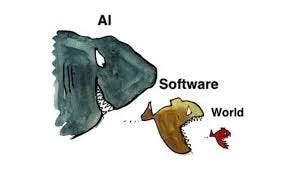A few days ago, I lauded Tech VC and luminary Marc Andreessen for addressing head on, the dystopian fears around AI, and simply outlined why this technology, like so many others before it, is likely going to do far more societal good than bad. “Why AI will save the world” indeed.
As he explains in mainstream language, researchers and entrepreneurs have been trying to make software that worked like the human brain literally for decades.
It’s just now, over 75 years after inventing the transistor, and over 50 years after Gordon Moore posited that computers would roughly double in power while halving the cost every couple of years or so, the laws of compounding have given us the hardware and software to make today’s AI do what it can amazingly do.
And that is, to in real time, take our questions, then run unimaginably complex loops of statistical analysis with them, against every imaginable set of digital data captured thus far, and provide predictive “answers” that feel like the “AI” knows us and understands us. (‘Sentient’, don’tcha know. Pro Tip: Not.).
All while just doing what computers have always done. Run code. Just much, much faster than even over five years ago, using processors (Graphical Processing Units, GPUs) that were designed over two decades ago to put pixels on a screen while playing video games.
The code that’s being run is code like we’ve run on computers since the days of the mainframes in the 1960s. It’s still 0’s and 1’s running really fast doing Math. As I said the other day:
“And yes, all software is Code. And all Code is Math. And Math is the Language of God. But none of it is sentient (The Math part, not the God part). (Not picking that fight today).”
It’s that there is a LOT more Math being run real time with AI (‘Artificial Intelligence’), and ML (‘Machine Learning’). The other technologies being run with intense and copious amounts of Math matrices, running in unimaginable amounts of real-time user generated reinforced feedback loops, are computations using LLMs (Large Language Models), and ‘Generative AI’.
In a later post, I will describe these “reinforced feedback loops” in far more detail, and how they make this AI technology cycle far more potent for Society (in mostly a VERY GOOD way), than the PC and Internet cycles have done over the last three plus decades. And provide immense new opportunities for both private and public investors. But those are for another day.
Today, just want to underline a key point that Marc actually started to make about Software in particular all the way back in 2011. When he put out his post on “How Software is eating the World”.
He was right. The piece is well worth reading again today. What’s important to note was the type of software he was mostly referring to was different than the AI software being used today, which uses A LOT MORE of that statistical math mentioned above.
These AI and ML driven statistical math loops are made possible by the aforementioned advances in GPUs that could simultaneously run huge amounts of probability loops, in parallel, and in real time.
And the company that made GPUs mainstream, was the thirty plus year ‘overnight’ wonder company Nvidia, which recently touched a trillion dollars in market cap and is worth over seven Intels. And currently is a “Gatekeeper” in the AI revolution in terms of how fast they and Taiwan Semiconductor (TSMC), who makes a lot of their chips, can put in the multibillion dollar facilities (aka Fabs), to crank out as many GPUs as eight plus billion people are going to need over the next few years.
Indeed, it’s notable that Nvidia founder/CEO Jensen Huang presciently said “AI eats software” all the way back in May 2017. That’s the year when Google’s AI transformative (pun intended) paper “Attention is all you need” paper first came out a month LATER, June 12, 2017.
Jensen then said “Software may be eating the world, but AI is eating Software”. Again, weeks before Google’s famous Transformer paper that now gave us OpenAI, GPT4, and of course ‘the ChatGPT moment’ over the last six months.
Here is the MIT article, May 12, 2017, that noted what Nvidia’s Jensen said, a month before the Google paper:
“We’re very early on. Very few lines of code in the enterprises and industries all over the world use AI today.
It’s quite pervasive in Internet service companies, particularly two or three of them. But there’s a whole bunch of others in tech and other industries that are trying to catch up.
Software is eating the world, but AI is going to eat software.”
Again, Marc Andreessen wrote his “Software is eating world“ paper in 2011.
But “AI Eats Software” in current version of the reinforced flywheel loops described above, in the billions and trillions, didn’t start to happen until ChatGPT taught even OpenAI, that the user driven loops would through reinforced learning and training, create the “emergent super intelligence behavior”, Microsoft researchers and others have been fervently discussing.
And it was that ‘surprise’ in increased relevance and reliability, that would really lead to “AI eating software’ in earnest.
It’s also to be noted here, that it’s the user driven feedback loops that are the AI software equivalent of transistors. Needed in the billions and trillions. A Key value driver. They’re what’s making AI eat traditional Software. Finally and at scale. Six years after Jensen noted it in its earlier Machine learning form.
And so, “AI eats Software” is happening at an accelerated computing trend of our time right now. As Marc and Jensen laid out years ahead.
Overnight success is never overnight. Stay tuned.




